I wish we could all be together this Nowruz.
I wish we weren’t all scattered across the country.
Scattered across the continent.
Scattered across the globe.
She sits in her dedicated spot at our kitchen table. Her words echo through the kitchen, twisting and turning, bouncing off you, looking and yearning for a spot to land, eventually finding their way out – seduced by the wide open door and a gentle late winter breeze.
Scattering across our parched lawn.
Across our parched city.
Across the country, the continent, the globe.
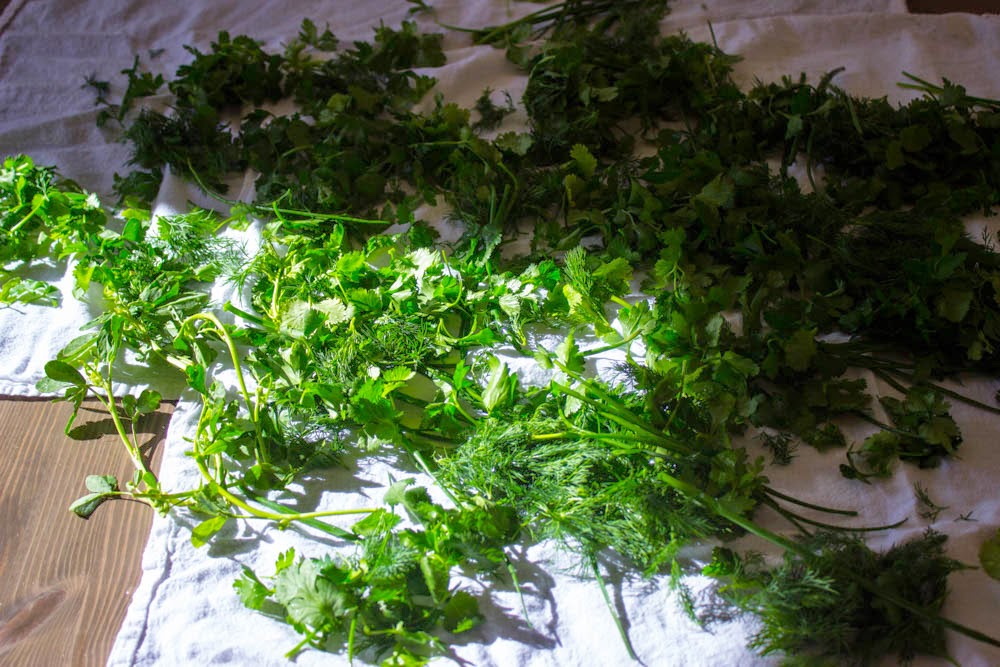
Slowly and meticulously she sorts through the bunches upon bunches of green herbs scattered before her.
Parsley, cilantro, dill, chives, tarragon, fenugreek, spinach, green onion, mint.
Fragrant and willing representatives of new life, new beginnings, and Spring. Nowruz. Persian New Year.
Back in those days – when I was a little girl – in Iran – everyone started their khooneh takooni – the shaking out of the house weeks before the new year.
She moves on to the cilantro. Notoriously difficult to sort through. Methodically her aged but still elegant hands pick the leaves off the stems. Setting the stems aside for a broth to be used for aash-e reshteh.
Windows would be washed, closets and attics would be sorted through, rugs would be swept and hung out to freshen up.
You turn your head, look over your shoulder, and sneak a quick glance at your carpet. Faded – but ever present markings of a certain time, a certain age staring right back at you. The spinach smoothie that got knocked over, the blueberry sauce that didn’t quite make it to its destination, the chocolate shavings forever embedded into its mosaic theme.

Then, on the night of Chaharshanbeh Suri (the last Tuesday night before Nowruz) my Aunt – Ammeh joon and Uncle – Amoo joon would take me to the Chaharshanbeh Suri bazaar. This was one of the joys of our childhood.
You glance up at the clock, hurriedly grab the sorted bunches of parsley, dill and chives and escort them to the sink. Scattering the herbs across the cool water.
All the streets would be lit up with lights, candles, colorful balloons, all sorts of decorations. The scent of the sonbol (hyacinth) drunkenly guiding us through the streets and alleyways.
She slowly but purposefully makes her way to the sink, nudging you away. You’ve rinsed the herbs twice. She thinks they need another rinse. Her hands reach into the cool water and gently, respectfully lift the greens in and out of the water.
Scattered showers.

Joyful music filled the streets. Everyone would be out selling their goods. Ajeeleh Chaharshanbeh Suri Tabrizi, the mixed nuts from Tabriz was the best. And all the kids would get to pick out their favorite candy. Everyone loved khooroos ghandi – the rooster-shaped, sweet, hard candy.
You quickly lay out fresh towels. And she patiently scatters the herbs across it to dry. A field of greens on your kitchen table. A most familiar sight.
Ammeh joon would do all her own Nowruz baking. All the families did their own baking then. Noon berenji (rice flour cookies) as thin as a piece of paper, noon nokhodchi (chickpea cookies) that would melt in your mouth. All baked on the manghal (a charcoal grill).
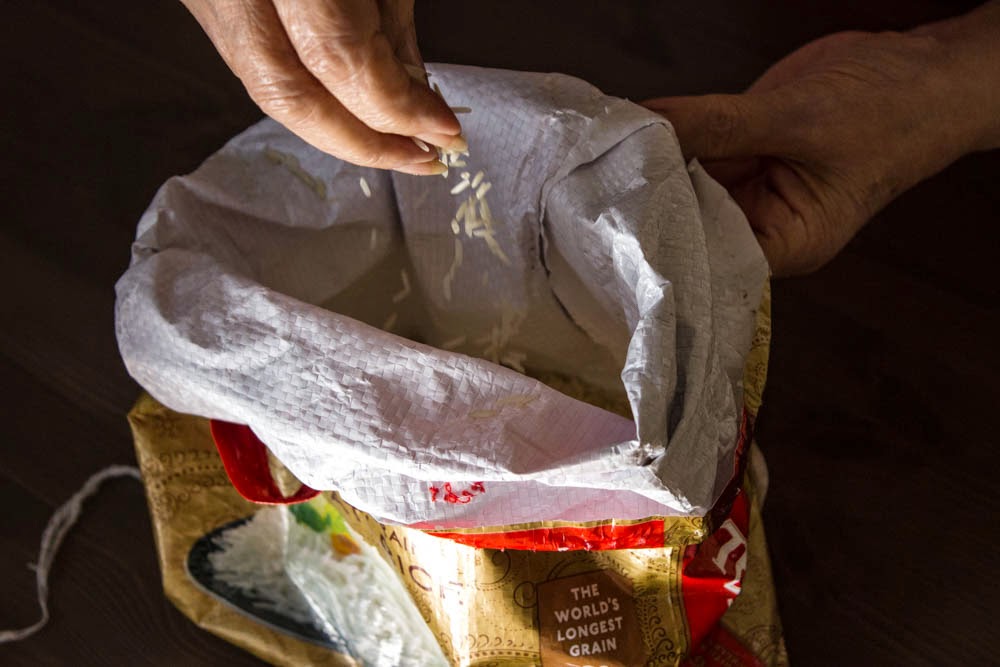
You grab the 10 lb sack of rice and watch as each grain clink-clanks into the bowl. A most familiar sound. You rinse the rice a few times – just like she taught you. Swirling it around and around with your finger. Rinse, drain, repeat until the water runs clear. Add fresh water and salt and set aside to soak for at least one hour. Just as she taught you.
Of course, Ammeh joon and all the ladies would pamper themselves days before Nowruz. Hair would be done, new clothes purchased, make-up beautifully applied. Everything and everyone should be fresh and new. Ammeh joon – she had the most beautiful, almond shaped, kohl-rimmed eyes. Those eyes. Those eyes.
Once again you transfer the herbs from the kitchen table back to the counter, to the food processor. Working in batches you pulse away until they are finely chopped. But not too finely chopped. It’s always a balancing act.
We used to do all this chopping by hand. A bunch of herbs, a board, and a knife.
Pulse. Pulse. Pulse.
It’s much easier and faster now with these machines.
Pulse. Pulse. Pulse.
But what you gain in time, you lose in flavor. There’s something about the blade of the knife that retains the fragrance and flavor of these delicate greens. But who has the time and patience now to chop all this by hand.
You bring a pot of salted water to a boil. You add the rice.
And there you pause.
Simultaneously. Both of you. Mother and daughter. At the rice pot.
Tradition, culture and the meaning of life contained in this one critical moment. Exactly when to drain the rice.
Each grain of rice should soften on the inside but still have a bite to it. Not too soon, not too late.
A balancing act.
You gently nudge her out of the way and grab the rice pot. Moving the pot from the stove to the sink is not an easy task for her anymore.
You drain the rice as now she gently nudges you out of the way to scatter some fresh water over the rice.

And then came Nowruz. The Sofreh Haft Seen would be set and we’d all gather around it. Ammeh joon always took such care to set out the most beautiful Sofreh Haft Seen. The same Zari (ornamental cloth) that you use now for your sofreh – she used then. And Amoo joon who was the elder of the family always had a bowl full of gold coins ready to be handed out. For prosperity, for luck in the new year.
You watch the butter melt, as she sprinkles the saffron. She scatters the rice over the bottom of the pot. The tahdig layer. She sets aside a cup full of freshly chopped herbs and scatters the rest – parsley, cilantro, fresh dill, chives, fenugreek – over the rice. And then some dried dill.
Back to the rice. The herbs. The dill. Repeat. Top off with a couple of fresh spring garlic. For its flavor, for its aroma. For spring.
I can still smell and taste our Nowruz meal. The koo koo sazi, aash-e reshteh, the smoked fish, the white fish.
You wrap a fresh towel over the lid and cover the pot. Let it steam and work its magic for an hour.
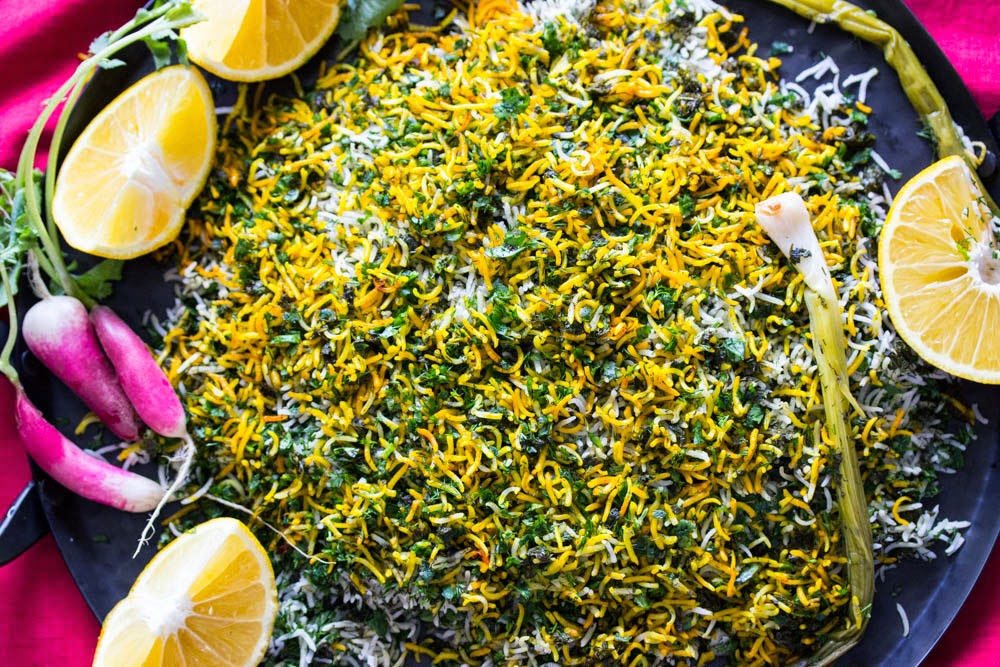
And of course it wouldn’t be Nowruz without Sabzi Polo – Green Herb Rice. Ammeh joon would always first set aside the best part of the tahdig for me. Just like I used to do for you and your brother. Just like you do now for the girls.
She lifts the lid off the pot and instantly the steam, and fragrant aromas of the herbs and rice echo through the kitchen, twisting and turning, bouncing off you, looking and yearning for a spot to land, eventually finding their way out – seduced by the wide open door and a gentle late winter breeze.
You set the platter right next to her. She makes room for you. But you ask her to serve the sabzi polo. Somehow, it always tastes better if she serves it. You watch as she delicately scatters the rice across the platter, followed by a layer of the fresh herbs she had set aside. Scatter the rice, scatter the fresh herbs, repeat, and top with golden saffron rice.
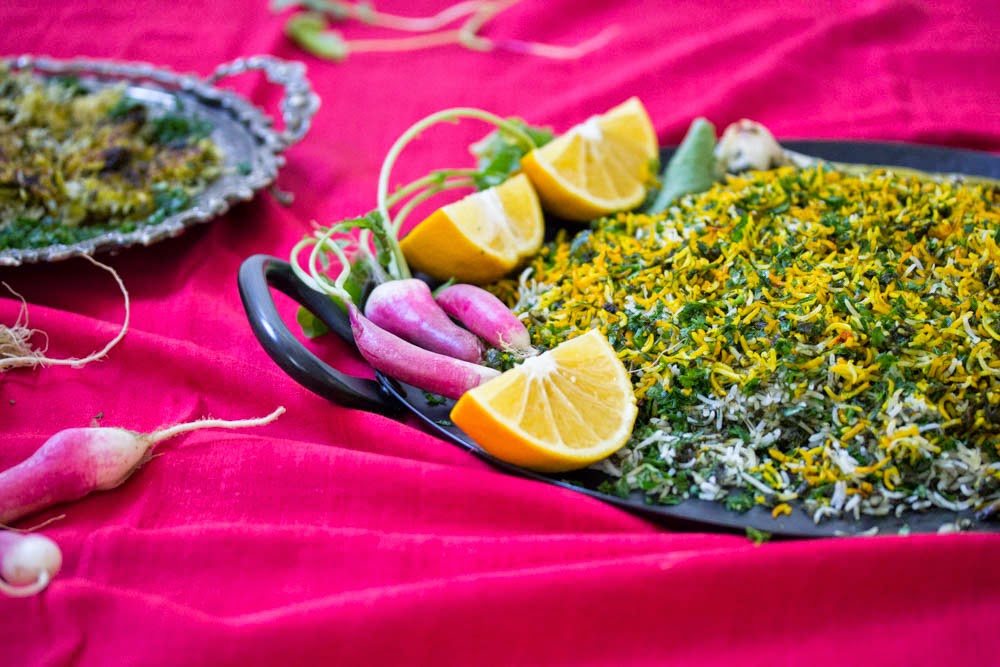
I wish we could all be together for Nowruz. Everyone. Even those that are long gone.
You take her hand and walk her to her spot at the kitchen table. As unexpected drops of rain fall to the ground. Taking your breath away.
Scattered showers.
The promise of new life, new beginnings, togetherness, a brand new year, Spring.
Nowruz.
This year we celebrate Nowruz on Friday, March 20th, 2015 at precisley 3:45pm PDT. Please take a moment to also enjoy the many tempting Nowruz dishes below from talented Persian food bloggers around the globe. Happy Nowruz!
A GREEN HERB RICE – SABZI POLO
Notes:
- For a more detailed guide to cooking Persian rice please see this post
- My preferred basmati rice right now is Royal Chef’s Choice I purchase mine from my local Persian store.
- I realize bunches of herbs come in varying sizes. I ask for large bunches here. Don’t get too caught up on this. Get a bunch as close to large as possible. I’m not a big believer in measuring out herbs by cups. You really can’t go wrong here if your bunch of herbs is medium sized or a little bigger than large. I also like to use the stems in homemade broth. You can even make pesto with the stems. Just seems a shame to compost all those stems.
- Fresh fenugreek can be found at farmer’s markets or Middle Eastern grocery stores.
- For the steaming portion of the rice and herbs I used my deep, 12″ cast iron skillet which worked great and turned out a great tahdig. I think a slightly bigger size would have also worked nicely. Giving the rice room to grow and elongate. If you do use a bigger pot or pan please adjust the amount of butter accordingly. If you do want to use a cast iron skillet instead of a pot you can’t use any size smaller than 12″ for this amount of rice.
Ingredients:
Serves 4-6
3 cups white basmati rice, washed and soaked in 2 cups cold water with 3 tablespoons salt for at least 1 hour
water
salt
1 large bunch parsley, cleaned and trimmed
1 large bunch cilantro, cleaned and trimmed
1 large bunch dill, cleaned and trimmed
1 large bunch chives, very roughly chopped
leaves from 5 stems of fresh fenugreek (optional)
5 tablespoons butter or ghee, divided
1/4 tsp ground saffron steeped in 1 tablespoon hot water, plus a small pinch
1/4 cup dried dill
2 whole cloves spring garlic, trimmed
1- Finely chop the first 5 ingredients in a food processor. Combine in a bowl. You can chop all the herbs together since you want them all combined, but you may need to work in batches to help your food processor. Set aside 3/4 cup of the chopped herbs. Keep the larger batch in the bowl.
2- In a large pot bring 12 cups water and 4 tablespoons salt to a boil. Once at a boil drain the rice and add the rice to the pot. Stir ONE TIME very gently. Return to a boil and keep a close eye on it. Skim off any foam. Test your rice after 4-6 minutes until the rice is al-dente. Once al-dente drain the rice (I usually drain the rice at the 4-5 minute mark) and give a quick gentle rinse under warm tap water. Allow the rice to drain completely. In the meantime, melt 3 1/2 tablespoons of butter and set aside.
3- In a large (not stainless steel) pot or a 12″ cast iron pan (see notes) melt 2 1/2 tablespoons butter or ghee over low heat. Make sure the melted butter covers the entire surface of your pot and along the sides. If not add more butter accordingly. Add a pinch of saffron to the oil and swirl around. With a spatula add enough rice to fully cover the bottom of the pot. Using the back of the spatula or the back of a wooden spoon pack down the rice firmly. Add a layer of the larger batch of chopped herbs. Sprinkle 1 tsp of dried dill over the fresh herbs. Repeat, alternating layers of rice, herbs, and dried dill. Your top layer should be a rice layer. Place the spring garlic on top, to the side of the pot. Pour the melted butter and 2 tablespoons hot water over the rice. Using the handle of a wooden spoon poke a couple of holes in the rice to allow the steam to escape. Cover and turn up the heat to medium/high. Cook for 10 minutes. (Don’t go anywhere! The tahdig can burn very quickly)
4- Turn down the heat to medium. Lift the lid and cover with a clean kitchen towel or a couple of layers of paper towel. Place the lid firmly back on the pot and cook for 10 minutes.
5- Turn the heat down to low. Place a heat diffuser under the pot and cook for 40 minutes.
6- When the rice is done, lift the lid and set aside the spring garlic. Gently scoop out 1 cup of the green herb rice in a bowl. Toss with the saffron water and set aside.
7- With a spatula gently scatter one layer of green herb rice on a serving platter. Make sure you don’t disturb the tahdig at the bottom of the pot. Add a layer of reserved fresh chopped herbs on top of the rice. Repeat, alternating layers of green herb rice and fresh chopped herbs. Garnish the very top with the reserved saffron rice and spring garlic. Gently scoop out the tahdig and serve on the side.
Sabzi polo is traditionally served with fish for Nowruz. It is also delicious with chicken kababs. Will keep in the fridge for up to 3 days.

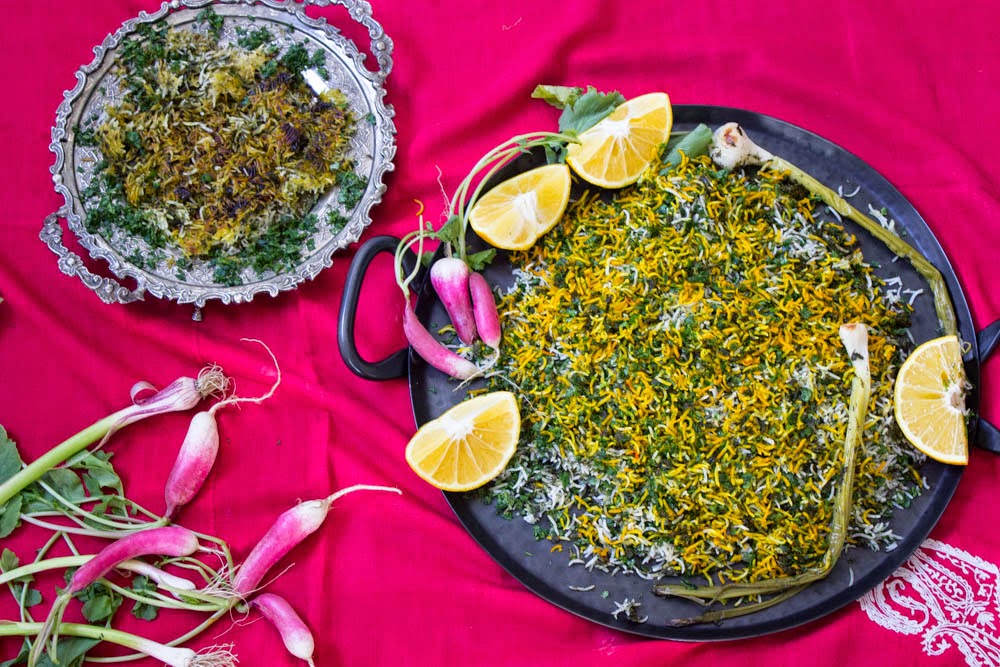

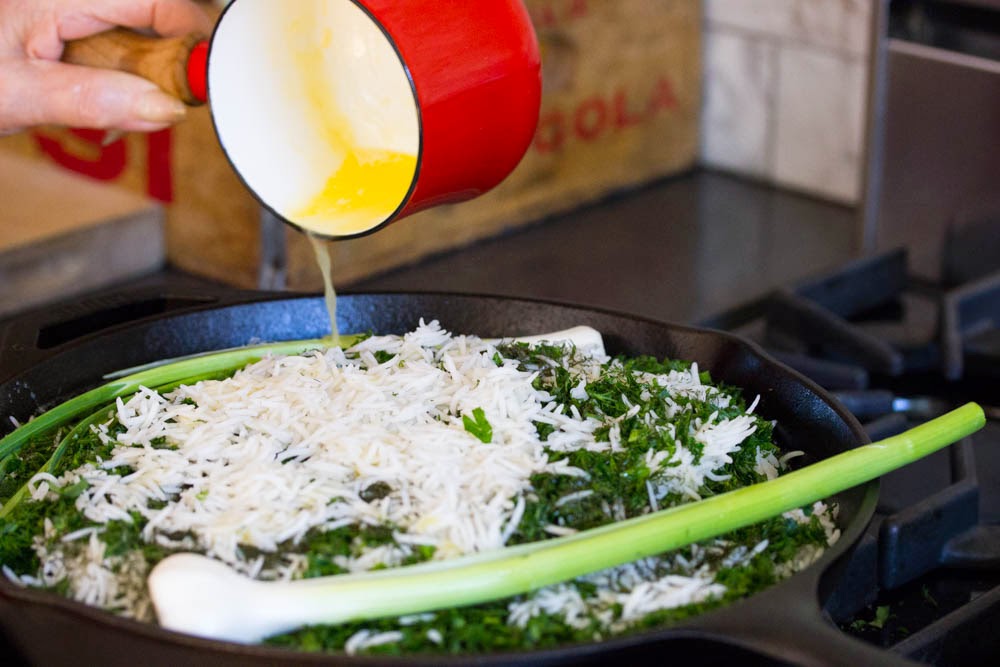

Comments (22)
Lovely writing, gorgeous pictures, and a delicious recipe…it can't get better than this. I miss Iran and my family like crazy, I wish we all could be together too.
Happy Nowruz xoxo
What a delightful Nowruz introduction with colorful and beautiful sofreh haft-seen. Sabzi polo makes Nowruz meal special, especially presented this spectacularly! Happy Nowruz to you and yours!
Beautiful memory! I never experienced Nowruz in Iran but I certainly loved tahdig. Much gratitude to my Iranian neighbors in Tehran who fed me every chance they could. <3
What a beautiful post, love all the fresh herbs you used in this rice dish. Take care!
I could eat my weight in this rice! Eid-eh shomah mobarak!
Such a lovely post! I enjoyed reading it, brought back so many sweet memories. 🙂
Beautiful words to go with beautiful pictures. This looks like a lovely dish that I might have to just try.
Thank you so much, Fae. The very same to you!
I send you a kiss, Fariba joon. Thank you!
What a sweet memory, Maureen! It's true. Once you try tahdig you're hooked! Thank you for sharing.
Thank so much, Cheri!
Thank you, Coco joon. Same to you and your family!
Thank you, Mojdeh. So glad you enjoyed it!
Thank you, Jordan. Please let me know if you do try!
Great easter breakfast idea!!
Beautiful post, gorgeous pictures and my very favorite rice in the world. Thank you for sharing your story and recipe.
Yummm this looks amazing
Mikolaj, I never thought of it, but yes you could also enjoy for breakfast!
Thanks so much, Homa joon!
Thanks, Ian. It really is a delicious roast!
به به به
چقدر خوب ، چقدر زیبا و چقدر مایه افتخار
This comment has been removed by the author.